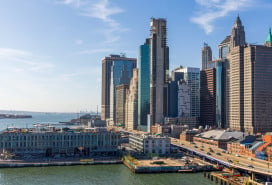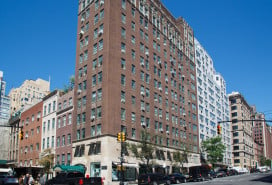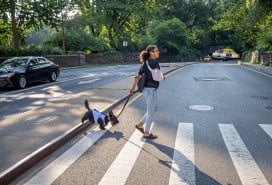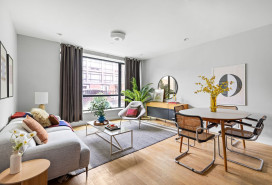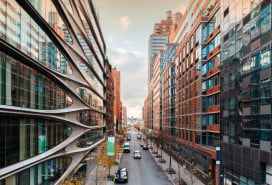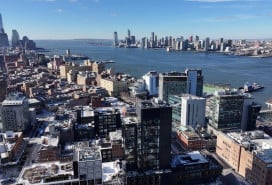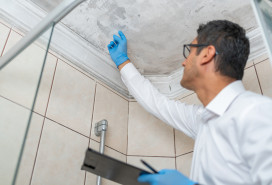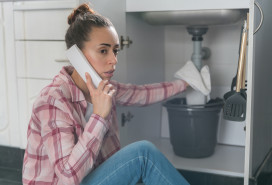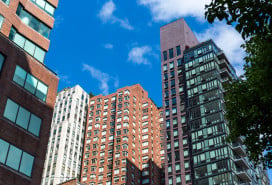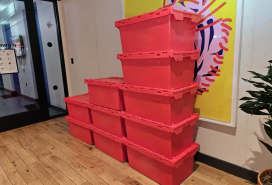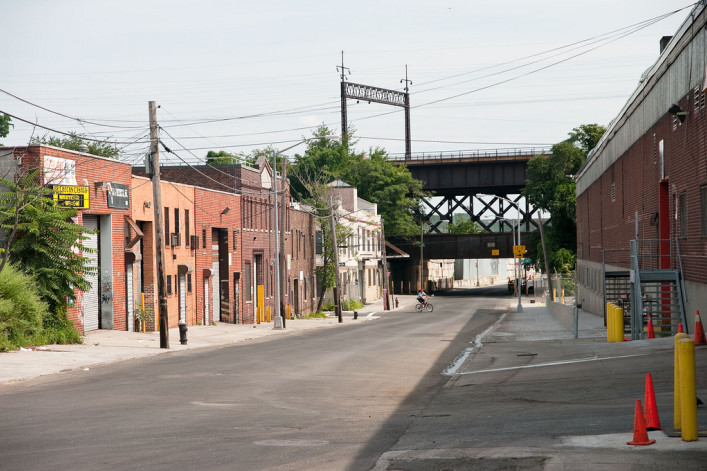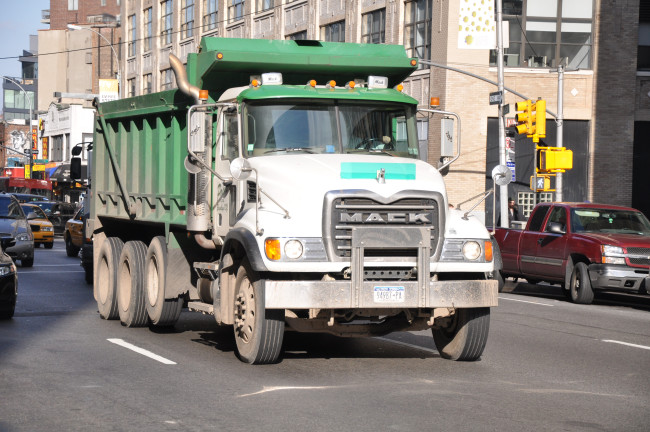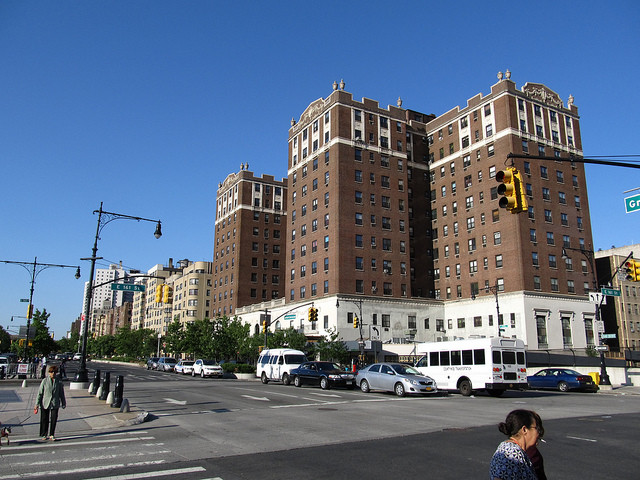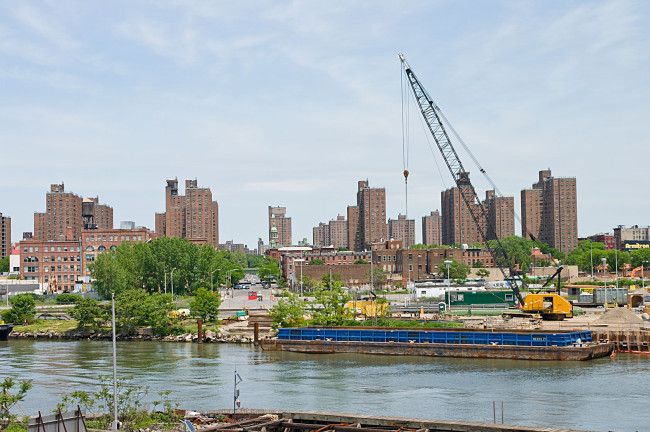A South Bronx reality check: How much change is the area really seeing?
The rebranding of neighborhoods is often seen as a harbinger of gentrification to come, and in recent years, both real estate developers and the media that covers their maneuvers have rechristened the South Bronx. As far back as 2005, the New York Times dubbed the area “SoBro,” citing an influx of “refugees” from pricier neighborhoods like the East Village and Williamsburg, who landed in the borough to banish blight and spark revitalization. (Though "refugee" seems an odd choice of phrase with which to characterize the kind of New Yorker who could afford to live in those neighborhoods in the first place.)
Last year, Curbed reported on Keith Rubenstein, a developer with Somerset Partners who wanted to dub Mott Haven “the Piano District,” a nod to its early-20th century identity as a home for piano production, in an effort to lend an aura of Brooklyn hipness to the area. In November, Rubenstein hosted a party with a "Bronx Is Burning" theme, complete with decorations like garbage fires and cars with bullet holes, to promote two new properties along the waterfront. It was a move many critics found to be a crass trivialization of the real struggles and accomplishments of longtime residents.
Overwriting what a neighborhood has been called for decades or even centuries can, for longtime residents, feel like a symbolic wiping clean of the slate, erasing a place’s identity in lieu of something more enticing for wealthier renters and buyers. Bronx locals reacted to the "Piano District" name with skepticism and mockery, launching a #WhatPianoDistrict hastag on Twitter to call out what they perceived as an aggressive push for gentrification.
City Council speaker Melissa Mark-Viverito joined the fray, writing, "It's beyond bad taste. Our community, my constituents, deserves respect, not that."
But are so many newcomers really trying to take over an area that already has a rich history and identity—and is the South Bronx about to change into something unrecognizable?
Telltale signs of gentrification in the South Bronx
Bottom line: The area is undergoing a metamorphosis, and it's picking up speed. According to the Furman Center’s State of New York City’s Housing & Neighborhoods report, Mott Haven, Hunts Point, Morrisania, and Belmont are among the city’s fastest-gentrifying areas; the first two saw a 28 percent increase in average rents from 2000 to 2014. At the same time, however, all four neighborhoods also experienced a decrease in average income during that same time period, meaning that it’s harder than ever for longtime residents to maintain a foothold in the area.
WNYC recently zeroed in on Mott Haven and the changes happening there, listing some telltale signs that gentrification has taken hold: developers snatching up warehouses along the previously untapped Harlem River waterfront, prices on rowhouses skyrocketing, young artists setting up shop, and community leaders mobilizing in response.
In WNYC’s broadcast, a resident named Sonya Santiago wonders, “It’s real good to live in the Bronx, but the rent is crazy… maybe they want to move these people out and bring the white people in.”
The concerns are not overblown: “What we’re seeing,” the WNYC reporter says, “is how gentrification gets started.” And in fact, last week Crain’s characterized the Bronx as the next Bushwick, a soon-to-be hub of NYC’s creative scene, noting the expansion of galleries and arts non-profits; the Bronx Museum in particularly is undergoing major growth, with the addition of new exhibition space.
Carmen Vega-Rivera, a leader with southwest Bronx tenants' advocacy group Community Action for Safer Aparments (CASA), sees the promotion of the area as a "new" hub for arts as an affront to the artists who have lived there for decades. "I came up from the Lower East Side in 1979 to work at the Bronx Museum. There's been an art scene for many years—it was there before I got there, it has been there, and it continues to be there," she says. "Now to say others are coming in and have the upper hand doesn't sit well with myself and many others."
Indeed, Rup Singh, a broker with ReMax who works in the Bronx, says that the vast majority of his clients are moving to the area from Brooklyn. “It’s becoming more young-oriented. Entrepreneurs and business owners are moving in slowly,” he says. “I really feel it’s going to be the next place where the best restaurants will be at, the best clubs or bars will be at.”
Chyann Sapp, a broker with Citi Habitats who both lives and works in the Bronx, confirms that artists are moving in, drawn by the warehouse vibe of the South Bronx. “There is increased interest for sure,” she says. “And Mott Haven is an easily commutable area compared to the rest of the Bronx, so it makes sense that people would be attracted there.” (A ride on the 2 from the Grand Concourse-149th Street station to Midtown takes only 25 minutes.)
Rezoning, revitalization, and new development in the area
There’s already work underway to make the South Bronx—where many residents do not have easy access to park space—greener. The Haven Project, for instance, is an initiative that intends to revitalize Mott Haven’s waterfront by renovating a derelict pier, improving access to Randall’s Island, and building an esplanade.
In the same area, Somerset Partners and the Chetrit Group have teamed up to purchase building sites, with plans to erect six new 25-story residential towers, according to The Real Deal; Somerset also bought a Bruckner Boulevard warehouse it intends to convert to an upscale food hall. (See their video below for details.)
The city, meanwhile, recently released a draft of its plan to rezone the Jerome Avenue corridor, reports City Limits, which will impact a 73-block area that extends from Highbridge to University Heights. The area is now primarily commercial, and the plan would allow the construction of residential space. Some of the new apartments would fall under Mandatory Inclusionary Housing, and the plan report notes that a “substantial proportion” of them would be affordable.
The Bronx Coalition for a Community Vision, which formed in response to the Jerome Avenue proposal, expressed disappointment in the draft. In a press release, the coalition wrote that the affordable housing plan fails to meet the needs of local Bronx residents; furthermore, “…it is not a community plan but a political one, focused on numbers rather than people, needs and community. If passed, it will represent displacement and gentrification— a removal of the poor instead of an investment in the community.”
Vega-Rivera, who worked with the coalition on developing a set of four principles to foster change without causing displacement, says the group met with city officials to share their ideas to no avail. "Nothing from the community's perspective was incorporated. We're saying we want change for those of us who have been living here and have been spending more than 50 percent of our income on rent, and yet we can't find affordable housing."
She adds that 45 percent of locals earn $20,000 or less a year, and the proposed affordable units will be out of reach for them. "Those are my neighbors," Vega-Rivera says. "Why are you building for those making twice as much?"
In a longer report, the coalition expressed concerns about the economic implications of displacing the auto industry in the Jerome Avenue area, as well as of the construction of new residences; it notes the need to hire locally in an area where there is currently a 15 percent unemployment rate. The report concludes, “We believe this plan is about relocation, gentrification and displacement. We say no to the plan and yes to the Bronx.”
Sapp says these concerns are legitimate: “I understand why people would be upset that the neighborhood is changing. And changing its name to SoBro or the Piano District is kind of a slap in the face to a lot of residents. Ultimately, though, that’s just the trajectory of NYC development.”
Singh says most of his clients, meanwhile, are less afraid of the neighborhood’s transformation than they are excited about the opportunities it represents. “I think they want change,” he says, adding that many sellers are older residents who want to retire to places like Florida, where they can enjoy a milder pace of life and warmer weather. Others, meanwhile, want to hold onto their property and let it appreciate a little longer.
The market
Singh offers a metric of how hot the market in the South Bronx is: “Any listing I get in the South Bronx sells within seven days,” he says. “Nothing sits on the market—you’ll find no inventory.”
A StreetEasy search reveals that indeed, the Bronx homes that have sat longest on the market are in the neighborhoods traditionally perceived as most desirable, like Riverdale and Fieldston, although there are listings like this one for a one-bedroom co-op in Highbridge that have languished for quite some time.
Chyann Sapp sees the fast-moving inventory as evidence that the area boasts what so many New Yorkers are looking for: convenience and space. The South Bronx, she adds, also delivers on something that can be difficult to find in a frenetically-paced city: a homey, neighborhood vibe. “There are a lot of residents that have been there for many years. People are saying it's reminiscent of Bushwick, Williamsburg, Park Slope,” Sapp says. “People are attracted to having that all in one neighborhood, and you’re still not too far from the city when you want to jump back in.”
In addition to Mott Haven, the area around the historic Grand Concourse thoroughfare—an area envisioned by its designer as NYC’s answer to the Champs-Élysées—is already booming. “The commercial and residential hub around 149th Street is spreading out,” says Sapp. There, she says, “you might pay the same price you’re paying in East Harlem but value is much greater” due to the spaciousness of the homes.
Sapp says she sees more renters than buyers at the moment, and the prices, while hardly rock-bottom, deliver more than what you’d find in Manhattan or Brooklyn. “You’ll find two-bedrooms that come with outdoor space for $2,800 per month, and one-bedrooms for $2,500 and a little bit lower than that,” she says, adding that there are still great deals out there, like the occasional two-bedroom for $2,100.
On the sales side, Singh says that young buyers are snapping up multi-family homes, an especially smart investment in the Bronx, where property taxes are low. “Instead of paying $3,400 for a one-bedroom in Manhattan, I can put that toward my mortgage and have every apartment in the building rented out, and end up with pocket money every month,” he says.
Longtime owners are well-aware of the growing interest in the area, he adds, and hoping to sell high. Singh has seen multi-family homes selling for between $600,000 and $800,000, and single families for $450,000 to $550,000.
“A lot of owners feel that they have a gem on their hands and that their house is worth $800,000 to $1 million,” Singh says. “The market isn’t there yet, but in two to four years it definitely will be.”
You Might Also Like


